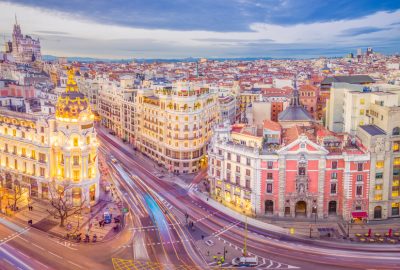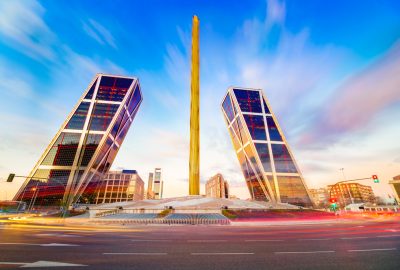Madrid stands for everything a modern European capital should be about: a rich cultural core with an entertaining nightlife outlining. It was built in 854, as one of many Muslim outposts that were supposed to protect the Iberian Peninsula from the Christian re-conquest. It was called Magerit back then, derived from majira, which means “water source” in Arabic. During the early 14th century Madrid began to attract the wealthy and powerful of Spain, because of its localization in the centre of the peninsula, but it was a pretty grim sight back then. People heard that the royal family was slowly settling there, so they followed the money, just to arrive to a huge mess. A hundred years later, Madrid started looking like a proper city, but only from a distance, towers and walls were built from dirt and mud, as was most of the housing. It’s funny how one of the worlds’ most impressive capitals started out as someone’s sandbox playground. 1561 was the year that this contrast of makeshift huts, palaces, noble villas and churches finally claimed the title of the First City of Spain. It took Madrid some five hundred years to become one of the most sophisticated and fun places on earth.

At Madrid's most famous streets Calle de Alcala and Gran Via you can feel the pulsing heartbeat of the city 24 hours per day
Gran Via is Madrid’s main street and the lifeline of the Spanish capital. Basically everything there is to see and experience in Madrid is on either side of that route. Callao Square (Plaza del Callao) is located, more or less, in the middle of that street, it’s Madrid’s own Times Square, I’m not a fan of all the billboards and advertisements but that’s the world we live in. There are shopping malls, cinemas, restaurants and cafes, but nothing special or worth mentioning. The entire area is infested with petty thieves and scammers so watch your back. Puerta del Sol is an another central and famous square, located at one of the former city gates. There you will see the statue El Oso y El Madrono (the Bear and the Strawberry Tree), the city’s symbol depicting a bear eating from a strawberry tree. I have to admit I didn’t even know that strawberries grew on trees. The square also contains the famous clock whose bells mark the traditional eating of the Twelve Grapes and the beginning of a new year. The San Miguel market is about 10 minutes away, an almost century-old market that recently got remodelled into one of the most hip spots in town. It’s this worldwide trend where markets aren’t just areas where you can buy fresh meats and produce, but also social centres where you can meet friends for spectacular food and drinks.
In Madrid almost everything is royal; even the main local football club Real Madrid. The Royal Palace is usually the most important part of any trip to Madrid. It’s among the largest in Europe and has been home to the royal family since the 9th century. There are 3500 rooms in that building. Just imagine the upkeep costs of something like that. It’s great from the outside but even better from the inside. Keep in mind that you’ll have to stand in lines for hours, especially during the summer. Personally I’d rather spend that time in the Sabatini Gardens, right next to the palace, great spot for a picnic. The Spanish like to take their time with everything, that no-rush, siesta mentality reflects in everything they do, particularly in building stuff. Take the Almudena Cathedral (Catedral de la Almudena) for example. They started the construction in the 16th century and finished in 1993. A period of 300 years: that’s a lot of siestas. While there you could enjoy an afternoon nap yourself when you would find a quiet place on the upper floor, overlooking the city.

Spectacular modern architecture at Plaza de Castilla, the big roundabout in Northern Madrid; the crooked KIO Towers (Torres KIO), also known as the Gate of Europe towers, make a great contrast with the golden obelisk Obelisco de Caja Madrid
Madrid is famous for its arts galleries. The Golden Three, also known as the Art Triangle or the Golden Triangle of Art assembly the three most interesting ones. The Thyssen Gallery boasts one of the most impressive collections in the word with pieces painted by Van Gogh, Rembrandt and many others. Reina Sofia is a piece of art by itself and Picasso’s masterpieces are just an addition. The Prado (officially: Museo Nacional del Prado) is the third and final stop on this art pilgrimage with a hoard so enormous they can only show a small percentage of it, even though the building itself is gigantic. Malasaña is the famous nightlife district where you go when you want to meet the locals and experience the culture from within. It is boasting bars, pubs, cafés, shops and best street food in town without breaking your budget. Sign up for one of those pub crawls advertised online, it’s a great way to meet some hot Spanish chicks, get wasted on free drinks while munching on those delicious tapas. Don’t miss out on flamenco, the unique Spanish dance and art form. Book for example a table at Corral dela Moreria (https://www.corraldelamoreria.com/). It’s one of the most recognized tablaos (venues dedicated to flamenco performances) in Madrid, where you can enjoy a very authentic show.



No one commented yet. Be the first.